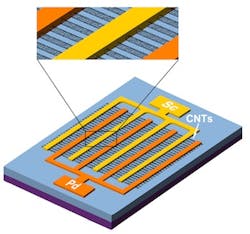Thermal IR detectors using single-walled carbon nanotubes are uncooled
Beijing, China--Researchers from Peking University, the Chinese Academy of Sciences, and Duke University (Durham, NC) have harnessed the properties of single-walled carbon nanotubes (SWNTs) to create highly sensitive uncooled photovoltaic IR detectors.1
Carbon nanotubes are an ideal nanomaterial for IR applications, says Sheng Wang, an associate professor at Peking University. “For starters, these nanotubes exhibit strong and broadband IR light absorption, which can be tuned by selecting nanotubes of different diameters," he notes. "Also, due to their high electron mobility, nanotubes react very rapidly—on the order of picoseconds—to IR light.” In comparison to traditional mercury cadmium telluride IR detectors, the SWNTs are an order of magnitude more efficient, the researchers report.
The photovoltaic IR detector is formed by aligning SWNT arrays on a silicon substrate. The nanotubes arrays are then placed between asymmetric palladium and scandium contacts. These two metals have properties that collectively create an Ohmic contact, which helps make the detector operate more efficiently. “Fabrication of carbon nanotube IR detectors can be readily implemented on a flexible substrate and large wafer at a low cost,” says Wang.
The detector demonstrated “acceptable sensitivity” at room temperature (responsivity of 9.87 × 10−5 A/W) and may be significantly improved by increasing the density of the SWNTs, according to the team. The signal-to-noise performance of conventional IR photodetectors is limited by their thermal IR emission, which is subsequently absorbed by the detector. To avoid having this stray radiation overwhelm the detector, liquid nitrogen or electric cooling is generally used to suppress this thermal effect. However, this is complex and expensive. The new design eliminates this need because at room temperature, carbon nanotubes emit comparatively little IR radiation of their own, especially when the carbon nanotube is on the substrate. In addition, nanotubes are very good at conducting heat, so temperatures do not build up on the detector itself.
One of the biggest surprises for the team was achieving relatively high IR detectivity (IR spectral detectivity of 1.09 × 107 cmHz1/2/W) using a carbon nanotube thin film only a few nanometers thick, Wang points out. Notably, conventional IR detectors require much thicker films, on the scale of hundreds of nanometers, to obtain comparable detectivity. Another advantage of the detector is that the fabrication process is completely compatible with carbon nanotube transistors, meaning no big expensive equipment changes are necessary. “Our doping-free chemical approach provides an ideal platform for carbon nanotube electronic and optoelectronic integrated circuits,” says Wang.
The next step for the team is to focus on improving the detectivity of the detector with greater SWNT density, and to also achieve a wide spectrum response with improved diameter control.
REFERENCE:
1. Qingsheng Zeng et al., Optical Materials Express, Vol. 2, Issue 6, pp. 839-848 (2012).
About the Author
John Wallace
Senior Technical Editor (1998-2022)
John Wallace was with Laser Focus World for nearly 25 years, retiring in late June 2022. He obtained a bachelor's degree in mechanical engineering and physics at Rutgers University and a master's in optical engineering at the University of Rochester. Before becoming an editor, John worked as an engineer at RCA, Exxon, Eastman Kodak, and GCA Corporation.

